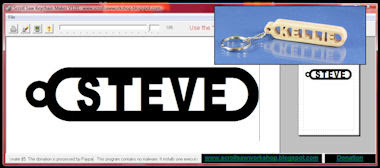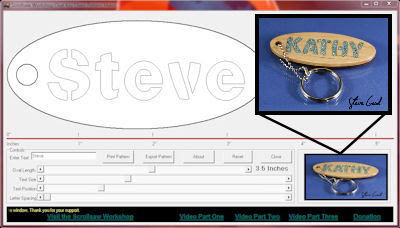If you have followed me on the blog for long you know that grammar and spelling are not exactly strong points of my skill set. When Mrs. Lewis, my high school English teacher tried to impress on me the importance of strong writing and speaking skills I only listened with one ear.
I certainly never thought that one day I would write every day. I absolutely never imagined that 30,000 to 40,000 people would read what I write every day. I have been actively working on improving my writing. I doubt that I will ever become a good writer but I hope to just be able to get my ideas across without confusing folks.
I plan to sit this cutting on my desk as a self-deprecating reminder that I need to improve.

Interior Starter Hole Position:
Click to Enlarge
Take a look at the image above. Note where I drilled most of the interior starter holes. I want to position the starter holes close to a transition point where I can begin the cut.
In the exploded section you see the actual starter hole (1) and another optional starter hole (2). I always prefer the option (1) because it allows me to begin the cut at a transition point rather than in the middle of a pattern line.
If I were to have chosen number (2) starter hole then I have to be very careful when I end the cut to try and line up the beginning and ending cuts. If I don't them up well I will have a nub that either has to be nibbled away with the blade or sanded away later. This just adds time.
In option (1) I will ent the cut at a transition and there will be no extra effort to hide the end of the cut.
This sounds trivial but on a project that may have dozens of interior cuts this time adds up and is just wasted effort.
There are situations where you don't have an option to put the starter hole at a transition point. Circles are a good example. In those cases, you just have to deal with the nub.

Better Dust Collection:
This is not new information but I still receive questions about dust collection every week so I wanted to repeat this past video. The video shows how I use the Dust Deputy cyclone separator to improve the shop vac.
The video was made back in 2017 but I still use the Dust Deputy and it has made my dust disposal much easier and quicker. It has been worth every penny to me.

$12 per sheet of 12 coins plus $3.50 shipping
Inlay with a 1" Forstner Bit.
The perfect way to sign your work.

Email Newsletter Readers: Remember that the Newsletter is just a copy of the daily blog post. To see the post in it's proper formatting click this link. If you ever misplace a pattern or any item you see here you can always find it on the blog. Everything stays on the blog forever.
Every Scrollsaw Workshop Pattern from 2007-2018 in DVD
Purchase the entire Scrollsaw Workshop pattern catalog for offline access.
This DVD has over 2,600 patterns published from 2007 thru 2018.
The DVD is $20 plus shipping. Ships to 60 countries around the world.
The DVD is $20 plus shipping. Ships to 60 countries around the world.
If you use the DVD on a Windows PC there is a simple viewer program to browse through the patterns.
The DVD also works fine on a MAC. The viewer program is not MAC compatible but there is an included PDF with all the patterns shown as thumbnails for easy viewing.
All the same file but on an easy to use a thumb drive. The USB thumb drive option is $23 plus shipping.
Now Available on USB Thumb Drive
Don't have a DVD drive on your new computer. No problem. Buy the catalog on a USB thumb drive.All the same file but on an easy to use a thumb drive. The USB thumb drive option is $23 plus shipping.
Scroll Saw Pattern Design Tutorial: DVD
Let me teach you to create a beautiful wooden portrait pattern. I will show you everything you need from start to finish. The video will show you the free software program you can download for Windows or Mac OS. I will show you how to install the program and configure it for best results.
Let me teach you to create a beautiful wooden portrait pattern. I will show you everything you need from start to finish. The video will show you the free software program you can download for Windows or Mac OS. I will show you how to install the program and configure it for best results.
Then I will show you the technique to take your photograph and make a pattern from it. When the pattern is complete we will go in the shop and cut it.
The DVD is $10 plus shipping. This is a data DVD that you will use on your computer to watch the video tutorial
My two "Wooden Vases on the Scroll Saw" books make it easy.
The books are $12 each and available for instant download after purchase. Click for Video Demonstration.
My Sponsors:
Support the businesses who support our community.
Home of Pegas scroll saw blades.






































